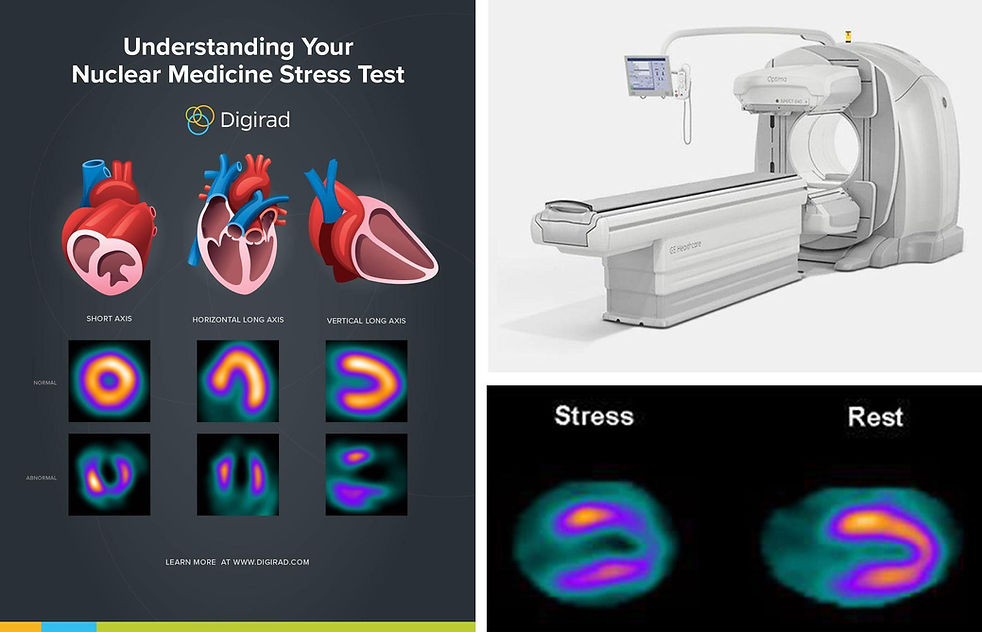Stress Testing

M. Haseeb, MD, FACC
Cardiologist located in Mt Vernon, IL
Stress Testing

What is stress testing?
Stress test evaluates the functional capacity of the heart both at rest and with exercise. The ideal stress test is EXERCISE TREADMILL STRESS TEST. Patients who cannot walk on the Treadmill undergo PHARMACOLOGIC STRESS TEST. This requires giving medication via the IV that produces changes in the functioning of the Heart similar to physical exercise. The Pharmacologic Stress test provides similar information to the Cardiologist about the performance of the heart and circulation status of the heart as the Treadmill Exercise stress test.
Why might I need a stress test?
Stress test is performed for either DIAGNOSTIC PURPOSES (to determine if symptoms of Chest discomfort, Shortness of breath, easy fatiguability, tiredness and fatigue are heart related due to compromise in heart circulation) or for PROGNOSTIC PURPOSES ( to determine how well the patient with established Coronary artery Disease/blockages in the arteries of the heart is doing on current medical therapy and what are his/her risks for undergoing a certain procedure/surgery.
Stress test is also done sometimes to evaluate progress after a heart attack or after Bypass surgery
How should I prepare for stress testing?

Do not drink COFFEE/TEA, SODAS or product containing caffeine/chocolate for 24 hours before the test
DO NOT eat, drink, or smoke for 3 hours before the test. Small amounts of water are allowed.
DO NOT use body oils or body lotions on the day of the test.
Do take your usual medications with water, unless instructed otherwise by your doctor or nurse.
Diabetics who use insulin or glucose-lowering agents may need to adjust their dosage. Please check with your physician if you are not sure.
Wear loose-fitting clothing that allows easy access to the chest and comfortable walking shoes.
Nuclear Stress Test: How does it work?
The heart pumps blood to every part of the body, and it too needs blood to work, just like any other muscle. When the heart muscle is exercised, it requires more blood to work harder. Sometimes, due to blockages within one or more coronary arteries, blood flow can be partially impeded or entirely blocked from reaching the heart muscle tissue. Inadequate blood supply to the heart is called ischemia. Ischemia can cause chest pain, shortness of breath, and decreased exercise tolerance in patients.
Test Description
The entire test will take about 3 hours.
Images of the blood supply to the heart can be acquired by using an injection of a radioactive tracer and viewing the tracer with a specialized radioisotope detecting camera. This is accomplished by establishing an intravenous catheter, usually called an IV, in a vein in the patient’s arm. A radioactive tracer also referred to as a radiopharmaceutical or radioisotope, is a small amount of radioactive material bound to a molecule that can enter the heart muscle cells (cardiac myocytes). The radioactive tracer itself does not cause the patient to feel any differently, and the radiation exposure received from the tracer is low.
The outline for the Rest/Stress protocol is as follows:
-
The patient arrives at the clinic fully prepared for the test as per the clinic’s instructions.
-
A nuclear medicine technologist or other medical professional inserts an IV to the patient’s arm.
-
A nuclear medicine technologist injects the radioactive tracer through the IV.
-
The patient waits 30 to 60 minutes to allow the tracer to distribute into the heart muscle.
-
The patient is placed on the camera, and images are acquired for up to 20 minutes.
-
The patient is connected to an electrocardiogram (ECG), so the heart rhythm can be monitored by a physician or other medical professional during the stress test.
-
If the patient can engage in physical exercise, a treadmill or stationary bicycle is used to elevate the patient’s heart rate. If not, the patient will receive a pharmacologic stress medicine to induce the exercised (stressed) state chemically.
-
At peak stress, a second radioactive tracer is injected to acquire the second set of images.
-
The patient is imaged again, usually within 15 to 45 minutes after the stress test.
-
After the 2nd imaging, the test is completed.

Is the stress test safe?
Stress testing is very safe. The likelihood of a serious complication (such as a heart attack or death) is less than 1 in 10,000. It is important to keep in mind that you will be continuously and extensively monitored throughout the test by experienced personnel and that the test will be stopped if there is any indication that continuing exercise would be unsafe in any way.
There are no reports of allergic reactions or side effects related to the injection of radioactive solutions. The radiation exposure from the test is very small (equivalent to that of several chest x-rays) and not associated with any significant health risk.
If you are pregnant or think you may be pregnant, you must let us know right away. Alternative testing may need to be arranged.
What happens after stress testing?
If you drive, you should be able to drive yourself back home unless instructed otherwise.
If you are a patient of MVHI, you will have a follow-up appointment to go over the results of the test. If you were referred to us only for the stress test, then the results of the test will be conveyed to your referring provider, who will then go over your testing results.
Featured Services








